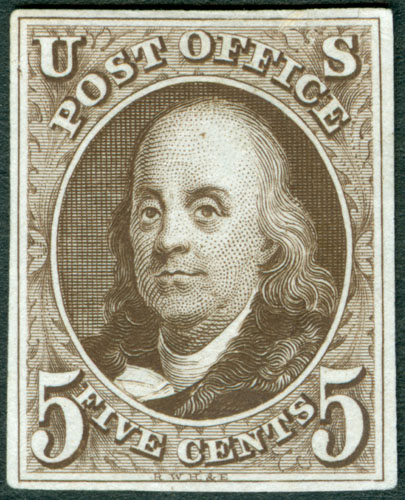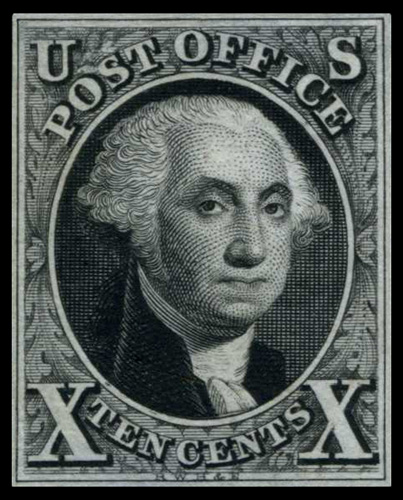
Year In Stamps - 1847
Politics
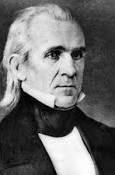
President
James K. Polk
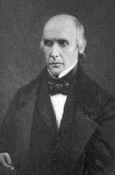
Postmaster General:
Cave Johnson
Music
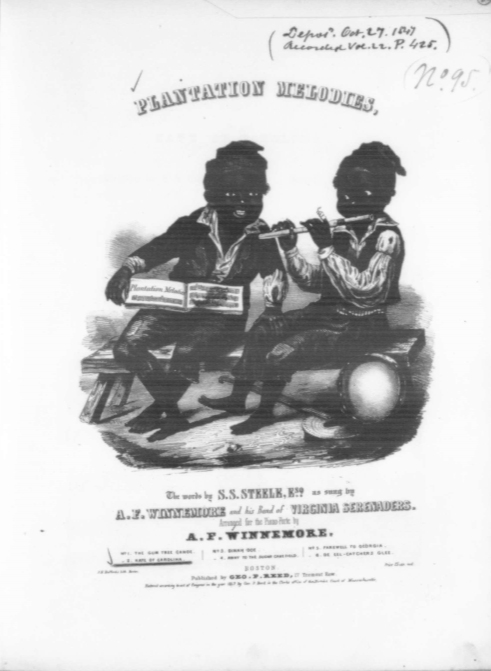
Click Control Above To Hear
1847 "Kate of Carolina"
Postage Rates
July 1, 1847 - June 30, 1851
Domestic Letter Rate per ½ oz:
5¢ for under 300 miles
10¢ for over 300 miles
40¢ to Pacific Coast
Between all places of the Pacific Coast per ½ oz.: 12½¢ (effective Aug. 14, 1848)
Drop Letter Rate: 2¢ - A drop letter is a letter that is dropped off and picked up at the same post office
Stamps
The First Regularly Issued Postage Stamps of the United States - By Bob Allen
Printed By the Rawdon, Wright, Hatch, and Edson Bank Note Company of New York City - engraved by Asher B. Durand
Printed on 200 subject plates in 2 panes of 100 in a 10x10 format and issued imperforate
Between 1847-1851 about 3.6 million of the 5¢ and 864,000 of the 10¢ stamps were issued.
The five- and ten-cent stamps of 1847 were the first adhesive postage stamps authorized for issue by the U.S. Post Office Department, in response to a law passed on March 3, 1847. The law was to take effect on July 1, 1847 and made illegal the use of postage stamps not authorized by the Postmaster General. It is something of a surprise that no two-cent stamp was issued, since two cents was the rate for drop letters, letters that were dropped off (mailed from) and picked up at the same Post Office.
Although the first stamps were supposed to be made available to the public by July 1, only the New York City Post Office received any stamps by that day, followed by Boston a day later, on July 2.
Covers with July 1847 dates are exceptionally rare and much sought after by collectors. The five-cent stamp paid for domestic letters within a 300 mile radius of the post office from which it was sent, and the ten-cent stamp for anything beyond that.
Many of the pre-July 1, 1847 stamps, including carriers, locals and provisionals, are items of great philatelic importance, but they are not covered here since they were not issued by authority of the U.S. Post Office Department. An excellent starting point to this fascinating subject may be found on the Carriers and Locals Society web site.
The requirement to prepay the postage was not part of this new law, and many letters were sent as they always had been, without stamps. It was expected that the person who received the letter would pay the fee. Drop letters would of course fall in this category, since there was no provision for a two-cent stamp. See the U.S. Philatelic Classics Society for more on the subject of stampless letters.
It must be pointed out that a great many of the letters of the day were sent stampless, that is without pre-payment. In fact, Carroll Chase estimated that only about one letter in fifty actually bore one of the 1847 issue stamps and the rest were to be paid on delivery. As can be imagined, there was some abuse when letters were distributed without pre-payment. Often a coded message was placed on the outside of a letter, and the recipient did not need to open the letter to determine its intent, leaving the mail carrier unpaid for his efforts. This abuse was curtailed somewhat in 1851 when the fee for a prepaid letter was dropped to three cents, meaning there was a two cent penalty for stampless letters, which still cost the addressee five cents. Finally, in 1855, it was required that all letters be prepaid and it has remained that way since.
The New York City bank note engraving firm of Rawdon, Wright, Hatch, and Edson were given a four year contract to print the first American postage stamps. The initials: "RWH&E" are clearly engraved at the bottom of both stamps. The firm did not come up with new designs for these important stamps, rather the engravings have been attributed to the portrait engraver Asher Brown Durand. According to Brazer, the identical Durand engraving of Franklin on the five-cent stamp, Number #1, had appeared on a $2.00 bank note of the Chemical Bank of New York, and the identical Durand engraving of Washington on the ten-cent stamp, Number #2, had appeared on a $5.00 bank note of the Fairfield County Bank (Connecticut). It is quite likely that the vignettes from the dies used to make these bank notes were used to make the dies for the new stamp designs.
Often overlooked is that these two stamps were originally proposed as bi-color stamps. In early submissions RWH&E suggested that the denominations be overprinted in red ink as a security measure, a common method of thwarting counterfeiters of paper money at the time, but the cost proved to be too high and the stamps were issued in the colors we know today, the five-cent in various shades of brown and the ten-cent in black.
In 1851, when the contract with Rawdon, Wright, Hatch, and Edson came to an end, the government solicited bids for the next series of stamps. At the same time they demonetized the stamps of 1847. After July 1, 1851, the first two U.S. stamps were no longer valid for postage. This has happened only one other time since, in 1861, when the Civil War required the Union to issue a new set of stamps to thwart the delivery of Confederate letters. All U.S. stamps since 1861 are still valid for use to pay the postage necessary to deliver a letter in the U.S.
There is some confusion as to whether more than one plate was used to print the five-cent stamp. Elliott Perry of "Pat Paragraphs" fame accomplished a major feat in U.S. philately by plating the ten-cent stamp and thereby proving that only one plate of 200 subjects of the ten-cent had ever existed.
One of the greatest American philatelists, Stanley Ashbrook, claimed that plating the five-cent stamp might prove impossible, since many of the printings are indistinct. It might seem strange that nearly every ten-cent stamp is sharp and crisply printed, while many of the five-cent stamps appear dull, muddy, and anything but sharp. Part of the problem is thought to be the poor quality of the brown ink used to print the stamps, or perhaps the way the ink was handled. Still, with the advent of the Internet and the ability to share crisp clean images from today's high quality scanners, the possibility of plating the five-cent stamp might come back within the realm of possibility, should a group of motivated researchers pool their resources. Perhaps the debate as to whether there was a "later" plate of the five-cent stamp may be put to rest, just as Perry did with the ten-cent stamp.
The five-cent stamp provides collectors with a fascinating variety of shades, running the gamut of pale brown to a very dark brown (nearly black), from red browns to a bright orange brown, from olive browns to violet browns, and even a full orange. A worthwhile and well-thought six-part treatise color varieties on the 1847 five-cent stamp, written by Calvet M. Hahn, has been made available on the Internet through the New York Chapter of the U.S. Philatelic Classics Society.
There is some confusion as to whether RWH&E destroyed all the dies and plates used to print these stamps. At any rate, in 1875, when the re-issues of all of the previous U.S. stamps were made, new dies needed to be created for the five- and ten-cent stamps of 1847. These "Special Printings" or "Reproductions" are readily distinguished from the regularly printed stamps. It is perhaps unfortunate that Number assigned catalog numbers of #3 and #4 to these stamps, since they were never intended as postage stamps, and they certainly were not the third and fourth U.S. postage stamps.
References and Suggested Reading:
· The United States Postage Stamps of the 19th Century, Vol.1 Lester Brookman
· Historical Catalog of U.S. Stamp Essays and Proofs 1847, Charles Brazer
· Classic United States Stamps 1845-1869, Carroll Chase
· Classic United States Imperforate Stamps, Jon Rose
· Number 2010 Specialized catalogue of U.S. Stamps and Covers
Websites of Interest to the 1847 Collector:
· Smithsonian
National Postal Museum - The 1847 Issue
· U.S.Philatelic Classics Society - The 1847 Period
· U.S. Philatelic Classics Society - New York Chapter(see:postal history articles by Calvet Hahn -below)
· 1847 Issue - Reexamining the Colors - in 6 parts - by Calvet Hahn
· The 1847 Issue - A Brief Synopsis - by Calvet M. Hahn
· Robert A. Siegel Auction Galleries, Inc. - 1847 Issue
